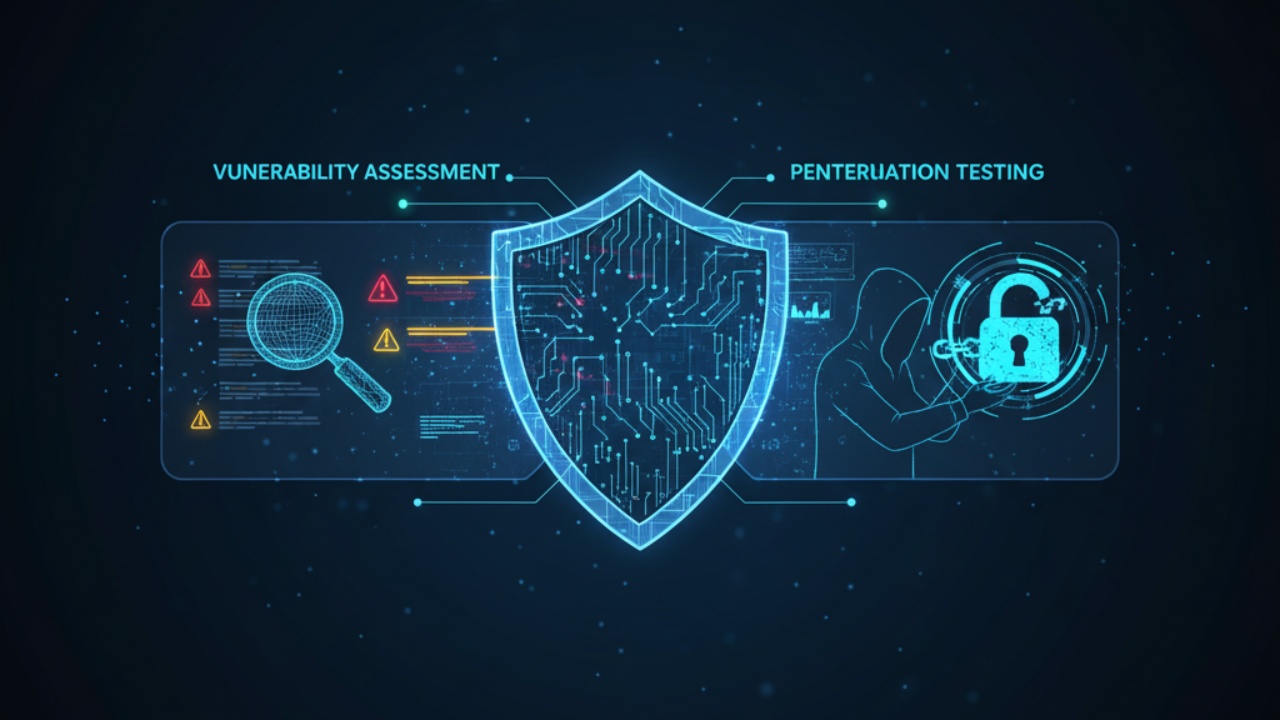
How VAPT Can Fortify Your Business Against Cyber Threats
- Home
- Cybersecurity
- How VAPT Can Fortify Your Business Against Cyber Threats

A VAPT (Vulnerability Assessment and Penetration Testing) is a powerful cybersecurity process that helps businesses find and fix security weaknesses before hackers can exploit them. It’s a proactive approach that combines two distinct but complementary services: Vulnerability Assessment and Penetration Testing. Think of it as a comprehensive health check for your digital systems, designed to ensure your data and operations are safe from both known and unknown threats.
The Two Halves of a VAPT
Understanding the difference between the two parts of VAPT is key to grasping its value.Vulnerability Assessment (VA)
This is the “look and find” phase. A VA uses automated scanning tools and manual analysis to systematically scan your systems, applications, and network infrastructure. It’s like a doctor performing a detailed physical exam. The goal is to identify and create a prioritized list of all known vulnerabilities, such as outdated software, weak configurations, or missing security patches. The report from a VA tells you what weaknesses exist and ranks them by severity.Penetration Testing (PT)
This is the “simulate and exploit” phase. A PT takes the process a step further by simulating a real-world cyberattack. Ethical hackers, or “pentesters,” attempt to exploit the vulnerabilities found during the VA. The objective is to see how far an attacker could get, what data they could access, and what kind of damage they could cause. A PT reveals the actual risk and impact of a vulnerability, answering the question: How could a hacker get in, and what would happen if they did? Together, VA and PT provide a comprehensive view of your security posture. The VA gives you a wide-ranging list of all potential problems, while the PT provides a deep, focused analysis of the most critical risks.Why VAPT is Non-Negotiable for Your Business 🛡️
In today’s digital landscape, a simple firewall isn’t enough. Here’s why VAPT is essential for any modern business:- Proactive Risk Mitigation: Instead of waiting for a breach to happen and reacting to the damage, VAPT allows you to find and fix security flaws before they are exploited. This saves you from the potentially devastating financial, legal, and reputational costs of a cyberattack.
- Enhanced Security Posture: By revealing your weaknesses and proving which ones are actually exploitable, VAPT helps you prioritize your security efforts and allocate resources effectively. You can focus on patching the most critical vulnerabilities first, strengthening your overall defenses.
- Regulatory Compliance: Many industry regulations and standards, such as PCI DSS (for payment card data), HIPAA (for healthcare data), and GDPR (for EU customer data), require regular security assessments. VAPT provides the documented proof you need to meet these compliance requirements and avoid hefty fines.
- Customer Trust: Demonstrating a commitment to cybersecurity through regular VAPT builds trust with your customers and partners. It shows that you take the protection of their sensitive data seriously, which is a powerful competitive advantage.
The VAPT Process: A Step-by-Step Approach
A typical VAPT follows a structured methodology to ensure a thorough and effective assessment:- Planning & Scoping: The security team works with you to define the scope of the test. This includes identifying which systems, applications, and networks will be tested, as well as the rules of engagement.
- Information Gathering: The team gathers as much public and private information about your systems as possible, scouting for potential entry points.
- Vulnerability Assessment: Automated tools and manual techniques are used to scan for known vulnerabilities. This phase generates a detailed report of all potential weaknesses.
- Penetration Testing (Exploitation): Ethical hackers attempt to exploit the identified vulnerabilities to demonstrate their real-world impact. They document how they gained access and what they were able to do.
- Reporting & Remediation: A comprehensive report is created with an executive summary and detailed technical findings. The report includes actionable recommendations for fixing the identified flaws.
- Re-testing: After you’ve implemented the fixes, the security team performs a re-test to verify that the vulnerabilities have been successfully patched and that no new issues were created.
Related Post
Your Everyday AI: Unlocking the Magic Behind the Screens
Outsourcing IT services allows businesses to reduce operational costs, access expert knowledge, and focus on core objectives while ensuring system reliability and security.
How AI Improves the Language Learning Experience
Discover how Artificial Intelligence is transforming language learning. From personalized lessons and real-time feedback to AI chatbots and immersive VR experiences, explore how AI makes…
Cloud Computing Essentials: Choosing the Right Platform for Your Business
As more companies move to the cloud, selecting the right service—AWS, Azure, or Google Cloud—can be challenging. This guide compares the top cloud platforms to…
We provide the expertise and support to propel your business forward in the digital landscape.
Address Business
Unit No 320 Sagar Sarita Industrail
Permises Co-op Soc Ltd, Prabhat
Industrial Complex,
Dashisar East Mumbai -400068
Dashisar East Mumbai -400068
Contact with us
Call: +918369581081
Working time
Mon - Sat: 9.00am - 6.00pm
Holiday : Closed











